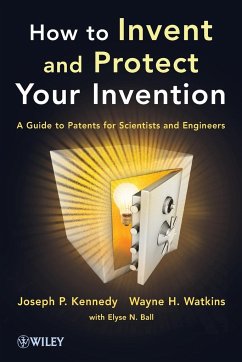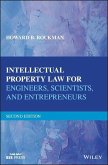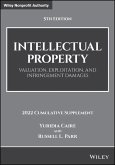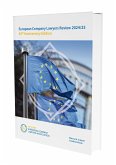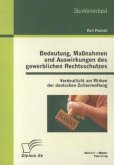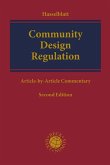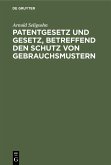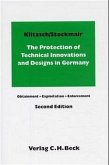- Broschiertes Buch
- Merkliste
- Auf die Merkliste
- Bewerten Bewerten
- Teilen
- Produkt teilen
- Produkterinnerung
- Produkterinnerung
A straightforward guide to inventing, patenting, and technology commercialization for scientists and engineers
Although chemists, physicists, biologists, polymer scientists, and engineers in industry are involved in potentially patentable work, they are often under-prepared for this all-important field. This book provides a clear, jargon-free, and comprehensive overview of the patenting process tailored specifically to the needs of scientists and engineers, including: Requirements for a patentable invention How to invent New laws created by President Obama's 2011 America Invents Act The…mehr
Andere Kunden interessierten sich auch für
![Intellectual Property Law for Engineers, Scientists, and Entrepreneurs Intellectual Property Law for Engineers, Scientists, and Entrepreneurs]() Howard B. RockmanIntellectual Property Law for Engineers, Scientists, and Entrepreneurs152,99 €
Howard B. RockmanIntellectual Property Law for Engineers, Scientists, and Entrepreneurs152,99 €![Intellectual Property Intellectual Property]() Yuridia CaireIntellectual Property160,99 €
Yuridia CaireIntellectual Property160,99 €![European Company Lawyers Review 2024/25 European Company Lawyers Review 2024/25]() European Company Lawyers Review 2024/2589,00 €
European Company Lawyers Review 2024/2589,00 €![Bedeutung, Maßnahmen und Auswirkungen des gewerblichen Rechtsschutzes: Verdeutlicht am Wirken der deutschen Zollverwaltung Bedeutung, Maßnahmen und Auswirkungen des gewerblichen Rechtsschutzes: Verdeutlicht am Wirken der deutschen Zollverwaltung]() Ralf PetzoldBedeutung, Maßnahmen und Auswirkungen des gewerblichen Rechtsschutzes: Verdeutlicht am Wirken der deutschen Zollverwaltung24,00 €
Ralf PetzoldBedeutung, Maßnahmen und Auswirkungen des gewerblichen Rechtsschutzes: Verdeutlicht am Wirken der deutschen Zollverwaltung24,00 €![Community Design Regulation Community Design Regulation]() Community Design Regulation273,99 €
Community Design Regulation273,99 €![Patentgesetz und Gesetz, betreffend den Schutz von Gebrauchsmustern Patentgesetz und Gesetz, betreffend den Schutz von Gebrauchsmustern]() Arnold SeligsohnPatentgesetz und Gesetz, betreffend den Schutz von Gebrauchsmustern184,95 €
Arnold SeligsohnPatentgesetz und Gesetz, betreffend den Schutz von Gebrauchsmustern184,95 €![The Protection of Technical Innovations and Designs in Germany The Protection of Technical Innovations and Designs in Germany]() Gottfried KlitzschThe Protection of Technical Innovations and Designs in Germany76,00 €
Gottfried KlitzschThe Protection of Technical Innovations and Designs in Germany76,00 €-
-
-
A straightforward guide to inventing, patenting, and technology commercialization for scientists and engineers
Although chemists, physicists, biologists, polymer scientists, and engineers in industry are involved in potentially patentable work, they are often under-prepared for this all-important field. This book provides a clear, jargon-free, and comprehensive overview of the patenting process tailored specifically to the needs of scientists and engineers, including:
Requirements for a patentable invention
How to invent
New laws created by President Obama's 2011 America Invents Act
The process of applying for and obtaining a patent in the U.S. and in foreign countries
Commercializing inventions and the importance of innovation
Based on lecture notes refined over twenty-five years at The University of Akron, How to Invent and Protect Your Invention contains practical advice, colorful examples, and a wealth of personal experience from the authors.
Hinweis: Dieser Artikel kann nur an eine deutsche Lieferadresse ausgeliefert werden.
Although chemists, physicists, biologists, polymer scientists, and engineers in industry are involved in potentially patentable work, they are often under-prepared for this all-important field. This book provides a clear, jargon-free, and comprehensive overview of the patenting process tailored specifically to the needs of scientists and engineers, including:
Requirements for a patentable invention
How to invent
New laws created by President Obama's 2011 America Invents Act
The process of applying for and obtaining a patent in the U.S. and in foreign countries
Commercializing inventions and the importance of innovation
Based on lecture notes refined over twenty-five years at The University of Akron, How to Invent and Protect Your Invention contains practical advice, colorful examples, and a wealth of personal experience from the authors.
Hinweis: Dieser Artikel kann nur an eine deutsche Lieferadresse ausgeliefert werden.
Produktdetails
- Produktdetails
- Verlag: Wiley & Sons
- 1. Auflage
- Seitenzahl: 226
- Erscheinungstermin: 28. August 2012
- Englisch
- Abmessung: 234mm x 156mm x 14mm
- Gewicht: 389g
- ISBN-13: 9781118369371
- ISBN-10: 1118369378
- Artikelnr.: 35456362
- Herstellerkennzeichnung
- Libri GmbH
- Europaallee 1
- 36244 Bad Hersfeld
- 06621 890
- Verlag: Wiley & Sons
- 1. Auflage
- Seitenzahl: 226
- Erscheinungstermin: 28. August 2012
- Englisch
- Abmessung: 234mm x 156mm x 14mm
- Gewicht: 389g
- ISBN-13: 9781118369371
- ISBN-10: 1118369378
- Artikelnr.: 35456362
- Herstellerkennzeichnung
- Libri GmbH
- Europaallee 1
- 36244 Bad Hersfeld
- 06621 890
Kasey Kennedy loves reading books and writing the stories in her head. She has a B.A. in English from Southern Illinois University; is a member of the Chicago Writers Association; Chicago North Romance Writers Association; and a 2021 participant in StoryStudio Chicago's Novel in a Year program.
Preface: How This Book Came to Be and for Whom It Is Written xi
Acknowledgments xix
Abbreviations xxi
1. The U.S. Patent System 1
1.1. What is a Patent? 1
1.2. Why Should You File A Patent? 5
2. Origins of U.S. Patent Law 7
2.1. A Brief History of Patent Law 8
2.2. The Fountainhead: The Constitution and the U.S. Patent System 9
2.3. Are Patents a Monopoly? 11
3. How to Invent: Intellectual Aspects Of Inventing 12
3.1. On the Definition of Creativity 12
3.2. A Flaw in Patent Law 13
3.3. Patentable Creativity 14
3.4. Intellectual Requirements of Inventing 15
3.5. The Process and Product of Inventing 16
3.6. Pioneering versus Mediocre Inventions: The Touch of the Expert 17
3.7. The Importance of Industrial Experience 17
3.8. The Ultimate Goal: Innovation 18
4. A Short Summary of Intellectual Property 20
4.1. Patents 21
4.2. Trade Secrets 21
4.3. Copyrights 22
4.4. Trademarks and Servicemarks 23
4.5. Other Types of Intellectual Property 24
5. Requirements of Patentability 26
5.1. What is Patentable? 26
5.2. Patentable and NonPatentable Subject Matter 27
5.3. The Three Classes of Patents 28
5.4. The First Law of Inventing 28
5.4.1. Utility 29
5.4.2. Novelty 31
5.4.2.1. The One-Year Rule 32
5.4.2.2. Derivation Proceedings 33
5.4.2.3. Anticipation 35
5.4.3. Unobviousness 35
5.4.3.1. Aggregates and Composites 37
5.4.3.2. The Teaching-Suggestion-Motivation Test 38
5.4.3.3. Secondary Factors Suggesting Unobviousness 39
5.4.3.4. The Doctrine of Inherency 40
5.4.3.5. Combination of References 41
5.4.3.6. New Compounds by Purification 41
5.4.3.7. Differences Between Novelty and Unobviousness 42
5.4.3.8. Why We Need Unobviousness 43
5.4.3.9. Summary of the Invention Content Law 43
5.5. The Second Law of Inventing 44
5.5.1. Conception 44
5.5.2. Reduction to Practice 46
5.5.3. The Prophetic Patent 46
5.6. The Structure of the Patent Document 48
5.6.1. The Cover Sheet 48
5.6.2. Specification 50
5.6.3. Claims 52
6. How Does the Patent Process Work? 55
6.1. The Notebook 56
6.2. The Provisional Patent Application 56
6.3. The (Regular or Nonprovisional) Patent Application 58
6.4. Prosecution: Convincing the Patent Examiner 60
6.4.1. Starting the Prosecution Process 61
6.4.2. The First Office Action 61
6.4.3. Allowances and Rejections by the PTO 62
6.4.4. The Duty of Candor 63
6.5. Continuation, Continuation-in-Part, and Divisional Applications 64
6.5.1. Continuation Applications 65
6.5.1.1. Differences Between Priority Dates and Filing Dates 65
6.5.1.2. Requirements for a Continuation Application 66
6.5.2. Continuation-in-Part Applications 67
6.5.3. Divisional Applications 68
6.6. Allowance and Issuance 68
6.7. Loss of Patent Rights 68
6.8. Challenges and Changes to Issued Patents 69
6.8.1. Post-Grant Review 69
6.8.2. Inter Partes Review 70
6.8.3. Reissue Application and Reissue Patents 70
6.8.4. Supplemental Examination 71
6.8.5. Summary of Post-Grant Proceedings 71
6.9. Summary of Chapters 5 and 6 73
7. Infringement and Freedom to Operate 74
7.1. The Parable of the Knife 75
7.1.1. The Story of Chlorobutyl Rubber 76
7.1.2. Anticipation versus Domination 77
7.2. Types of Infringement 77
7.2.1. Literal (or Direct) Infringement 78
7.2.2. The Doctrine of Equivalents 78
7.2.3. Contributory Infringement 79
7.3. Infringement Suits 79
7.4. When to Sue an Infringer 80
7.5. Freedom to Operate 80
7.5.1. Patent Trolls 81
7.5.2. Submarine Patents 82
7.6. Prior Commercial Use Rights 82
7.6.1. Personal Defenses 82
7.6.2. Exceptions to the Prior Commercial Use Defense 83
8. Biotechnology, Computer Software, and Business Method Patents 84
8.1. Biology Meets Patents 85
8.1.1. The Supreme Court: Living Things Are Patentable 85
8.1.2. The Budapest Treaty 86
8.1.3. The Consequences of the Supreme Court's Ruling 86
8.2. Computer Software Patents 89
8.3. Business Method Patents 90
9. Who Is the Inventor? 91
9.1. Conceiving an Inventive Idea 92
9.2. Joint Inventors 93
9.3. Naming Inventors on Patent Applications 95
9.4. Qualifications to Be an Inventor 95
10. Ownership 96
10.1. Selling, Licensing and Assigning Patents 97
10.2. Hired-to-Invent and Shop Rights 97
10.3. Inventing on Your Own Time 98
10.4. Non-Compete Agreements 98
10.5. The Bayh-Dole Act 99
10.5.1. March-In Rights 100
10.5.2. University Technology Transfer 101
11. Translating Ideas into Economic Reward 102
11.1. The Costs of Patenting 102
11.1.1. Legal Fees 103
11.1.2. Patent Application Fees 103
11.1.3. Patent Maintenance Fees 104
11.2. Assessment 104
11.2.1. Technology Validation 105
11.2.2. Protection Validation 105
11.2.2.1. Assessing Patent Protection 105
11.2.2.2. Assessing Trade Secret Protection 106
11.2.2.3. The Economic Espionage Act 107
11.2.2.4. Non-Disclosure Agreements (NDAs) 108
11.2.3. Commercial Viability and Market Assessment 109
11.3. Selling and Licensing a Patent 110
11.3.1. Licensors and Licensees 110
11.3.2. Exclusive versus Nonexclusive Licenses 111
11.4. Start-Ups, Spin-Outs, and Joint Ventures 112
11.5. Patenting and Marketing Departments; Technology Transfer Offices 113
11.6. Patent Valuation 114
12. Foreign Patents 116
12.1. Distinctive Features of U.S. Patent Law 117
12.2. The International Patent Cooperation Treaty 118
12.2.1. PCT Examination Procedures 118
12.2.2. Deciding Whether to File a PCT 119
12.2.3. The Patent Prosecution Highway 119
12.3. The European Patent Union 120
12.3.1. European Patent Office Procedures 120
12.3.2. Nationalization of European Patents 121
12.4. Other Foreign Patent Practices 121
12.4.1. Claims Interpretation 121
12.4.2. Patent Examination Procedures Abroad 122
12.4.3. Centralized Patent Offices 122
12.4.4. Procedures for Rewarding Inventors 122
12.5. Enforcing Patents Abroad 123
12.6. Choosing Whether to File a Foreign Patent Application 124
13. Innovation 125
13.1. Innovation Is More Than Invention 125
13.2. What Drives Innovation 126
13.3. The Law of Innovation 126
13.4. Companies and Innovation 127
13.5. The Innovation and Job Creation Relationship 127
13.6. Discovery Push versus Market Pull Innovation 128
13.7. Incremental versus Disruptive Innovation 128
13.8. Sources of Innovation 129
13.9. Innovation and Public Policy 129
14. Concluding Thoughts 131
14.1. Is the Patent System Worth the Costs? 131
14.2. The Patent System Leads to Additional Research and Knowledge Creation
133
14.3. Fostering Competition 134
14.4. Results of Ignorance of the Patent System 135
14.5. How Law and Technology Yield Patents 136
Appendix 1: Important Forms 139
Appendix 2: Self-assessment Questions 177
Glossary 196
Index 209
Acknowledgments xix
Abbreviations xxi
1. The U.S. Patent System 1
1.1. What is a Patent? 1
1.2. Why Should You File A Patent? 5
2. Origins of U.S. Patent Law 7
2.1. A Brief History of Patent Law 8
2.2. The Fountainhead: The Constitution and the U.S. Patent System 9
2.3. Are Patents a Monopoly? 11
3. How to Invent: Intellectual Aspects Of Inventing 12
3.1. On the Definition of Creativity 12
3.2. A Flaw in Patent Law 13
3.3. Patentable Creativity 14
3.4. Intellectual Requirements of Inventing 15
3.5. The Process and Product of Inventing 16
3.6. Pioneering versus Mediocre Inventions: The Touch of the Expert 17
3.7. The Importance of Industrial Experience 17
3.8. The Ultimate Goal: Innovation 18
4. A Short Summary of Intellectual Property 20
4.1. Patents 21
4.2. Trade Secrets 21
4.3. Copyrights 22
4.4. Trademarks and Servicemarks 23
4.5. Other Types of Intellectual Property 24
5. Requirements of Patentability 26
5.1. What is Patentable? 26
5.2. Patentable and NonPatentable Subject Matter 27
5.3. The Three Classes of Patents 28
5.4. The First Law of Inventing 28
5.4.1. Utility 29
5.4.2. Novelty 31
5.4.2.1. The One-Year Rule 32
5.4.2.2. Derivation Proceedings 33
5.4.2.3. Anticipation 35
5.4.3. Unobviousness 35
5.4.3.1. Aggregates and Composites 37
5.4.3.2. The Teaching-Suggestion-Motivation Test 38
5.4.3.3. Secondary Factors Suggesting Unobviousness 39
5.4.3.4. The Doctrine of Inherency 40
5.4.3.5. Combination of References 41
5.4.3.6. New Compounds by Purification 41
5.4.3.7. Differences Between Novelty and Unobviousness 42
5.4.3.8. Why We Need Unobviousness 43
5.4.3.9. Summary of the Invention Content Law 43
5.5. The Second Law of Inventing 44
5.5.1. Conception 44
5.5.2. Reduction to Practice 46
5.5.3. The Prophetic Patent 46
5.6. The Structure of the Patent Document 48
5.6.1. The Cover Sheet 48
5.6.2. Specification 50
5.6.3. Claims 52
6. How Does the Patent Process Work? 55
6.1. The Notebook 56
6.2. The Provisional Patent Application 56
6.3. The (Regular or Nonprovisional) Patent Application 58
6.4. Prosecution: Convincing the Patent Examiner 60
6.4.1. Starting the Prosecution Process 61
6.4.2. The First Office Action 61
6.4.3. Allowances and Rejections by the PTO 62
6.4.4. The Duty of Candor 63
6.5. Continuation, Continuation-in-Part, and Divisional Applications 64
6.5.1. Continuation Applications 65
6.5.1.1. Differences Between Priority Dates and Filing Dates 65
6.5.1.2. Requirements for a Continuation Application 66
6.5.2. Continuation-in-Part Applications 67
6.5.3. Divisional Applications 68
6.6. Allowance and Issuance 68
6.7. Loss of Patent Rights 68
6.8. Challenges and Changes to Issued Patents 69
6.8.1. Post-Grant Review 69
6.8.2. Inter Partes Review 70
6.8.3. Reissue Application and Reissue Patents 70
6.8.4. Supplemental Examination 71
6.8.5. Summary of Post-Grant Proceedings 71
6.9. Summary of Chapters 5 and 6 73
7. Infringement and Freedom to Operate 74
7.1. The Parable of the Knife 75
7.1.1. The Story of Chlorobutyl Rubber 76
7.1.2. Anticipation versus Domination 77
7.2. Types of Infringement 77
7.2.1. Literal (or Direct) Infringement 78
7.2.2. The Doctrine of Equivalents 78
7.2.3. Contributory Infringement 79
7.3. Infringement Suits 79
7.4. When to Sue an Infringer 80
7.5. Freedom to Operate 80
7.5.1. Patent Trolls 81
7.5.2. Submarine Patents 82
7.6. Prior Commercial Use Rights 82
7.6.1. Personal Defenses 82
7.6.2. Exceptions to the Prior Commercial Use Defense 83
8. Biotechnology, Computer Software, and Business Method Patents 84
8.1. Biology Meets Patents 85
8.1.1. The Supreme Court: Living Things Are Patentable 85
8.1.2. The Budapest Treaty 86
8.1.3. The Consequences of the Supreme Court's Ruling 86
8.2. Computer Software Patents 89
8.3. Business Method Patents 90
9. Who Is the Inventor? 91
9.1. Conceiving an Inventive Idea 92
9.2. Joint Inventors 93
9.3. Naming Inventors on Patent Applications 95
9.4. Qualifications to Be an Inventor 95
10. Ownership 96
10.1. Selling, Licensing and Assigning Patents 97
10.2. Hired-to-Invent and Shop Rights 97
10.3. Inventing on Your Own Time 98
10.4. Non-Compete Agreements 98
10.5. The Bayh-Dole Act 99
10.5.1. March-In Rights 100
10.5.2. University Technology Transfer 101
11. Translating Ideas into Economic Reward 102
11.1. The Costs of Patenting 102
11.1.1. Legal Fees 103
11.1.2. Patent Application Fees 103
11.1.3. Patent Maintenance Fees 104
11.2. Assessment 104
11.2.1. Technology Validation 105
11.2.2. Protection Validation 105
11.2.2.1. Assessing Patent Protection 105
11.2.2.2. Assessing Trade Secret Protection 106
11.2.2.3. The Economic Espionage Act 107
11.2.2.4. Non-Disclosure Agreements (NDAs) 108
11.2.3. Commercial Viability and Market Assessment 109
11.3. Selling and Licensing a Patent 110
11.3.1. Licensors and Licensees 110
11.3.2. Exclusive versus Nonexclusive Licenses 111
11.4. Start-Ups, Spin-Outs, and Joint Ventures 112
11.5. Patenting and Marketing Departments; Technology Transfer Offices 113
11.6. Patent Valuation 114
12. Foreign Patents 116
12.1. Distinctive Features of U.S. Patent Law 117
12.2. The International Patent Cooperation Treaty 118
12.2.1. PCT Examination Procedures 118
12.2.2. Deciding Whether to File a PCT 119
12.2.3. The Patent Prosecution Highway 119
12.3. The European Patent Union 120
12.3.1. European Patent Office Procedures 120
12.3.2. Nationalization of European Patents 121
12.4. Other Foreign Patent Practices 121
12.4.1. Claims Interpretation 121
12.4.2. Patent Examination Procedures Abroad 122
12.4.3. Centralized Patent Offices 122
12.4.4. Procedures for Rewarding Inventors 122
12.5. Enforcing Patents Abroad 123
12.6. Choosing Whether to File a Foreign Patent Application 124
13. Innovation 125
13.1. Innovation Is More Than Invention 125
13.2. What Drives Innovation 126
13.3. The Law of Innovation 126
13.4. Companies and Innovation 127
13.5. The Innovation and Job Creation Relationship 127
13.6. Discovery Push versus Market Pull Innovation 128
13.7. Incremental versus Disruptive Innovation 128
13.8. Sources of Innovation 129
13.9. Innovation and Public Policy 129
14. Concluding Thoughts 131
14.1. Is the Patent System Worth the Costs? 131
14.2. The Patent System Leads to Additional Research and Knowledge Creation
133
14.3. Fostering Competition 134
14.4. Results of Ignorance of the Patent System 135
14.5. How Law and Technology Yield Patents 136
Appendix 1: Important Forms 139
Appendix 2: Self-assessment Questions 177
Glossary 196
Index 209
Preface: How This Book Came to Be and for Whom It Is Written xi
Acknowledgments xix
Abbreviations xxi
1. The U.S. Patent System 1
1.1. What is a Patent? 1
1.2. Why Should You File A Patent? 5
2. Origins of U.S. Patent Law 7
2.1. A Brief History of Patent Law 8
2.2. The Fountainhead: The Constitution and the U.S. Patent System 9
2.3. Are Patents a Monopoly? 11
3. How to Invent: Intellectual Aspects Of Inventing 12
3.1. On the Definition of Creativity 12
3.2. A Flaw in Patent Law 13
3.3. Patentable Creativity 14
3.4. Intellectual Requirements of Inventing 15
3.5. The Process and Product of Inventing 16
3.6. Pioneering versus Mediocre Inventions: The Touch of the Expert 17
3.7. The Importance of Industrial Experience 17
3.8. The Ultimate Goal: Innovation 18
4. A Short Summary of Intellectual Property 20
4.1. Patents 21
4.2. Trade Secrets 21
4.3. Copyrights 22
4.4. Trademarks and Servicemarks 23
4.5. Other Types of Intellectual Property 24
5. Requirements of Patentability 26
5.1. What is Patentable? 26
5.2. Patentable and NonPatentable Subject Matter 27
5.3. The Three Classes of Patents 28
5.4. The First Law of Inventing 28
5.4.1. Utility 29
5.4.2. Novelty 31
5.4.2.1. The One-Year Rule 32
5.4.2.2. Derivation Proceedings 33
5.4.2.3. Anticipation 35
5.4.3. Unobviousness 35
5.4.3.1. Aggregates and Composites 37
5.4.3.2. The Teaching-Suggestion-Motivation Test 38
5.4.3.3. Secondary Factors Suggesting Unobviousness 39
5.4.3.4. The Doctrine of Inherency 40
5.4.3.5. Combination of References 41
5.4.3.6. New Compounds by Purification 41
5.4.3.7. Differences Between Novelty and Unobviousness 42
5.4.3.8. Why We Need Unobviousness 43
5.4.3.9. Summary of the Invention Content Law 43
5.5. The Second Law of Inventing 44
5.5.1. Conception 44
5.5.2. Reduction to Practice 46
5.5.3. The Prophetic Patent 46
5.6. The Structure of the Patent Document 48
5.6.1. The Cover Sheet 48
5.6.2. Specification 50
5.6.3. Claims 52
6. How Does the Patent Process Work? 55
6.1. The Notebook 56
6.2. The Provisional Patent Application 56
6.3. The (Regular or Nonprovisional) Patent Application 58
6.4. Prosecution: Convincing the Patent Examiner 60
6.4.1. Starting the Prosecution Process 61
6.4.2. The First Office Action 61
6.4.3. Allowances and Rejections by the PTO 62
6.4.4. The Duty of Candor 63
6.5. Continuation, Continuation-in-Part, and Divisional Applications 64
6.5.1. Continuation Applications 65
6.5.1.1. Differences Between Priority Dates and Filing Dates 65
6.5.1.2. Requirements for a Continuation Application 66
6.5.2. Continuation-in-Part Applications 67
6.5.3. Divisional Applications 68
6.6. Allowance and Issuance 68
6.7. Loss of Patent Rights 68
6.8. Challenges and Changes to Issued Patents 69
6.8.1. Post-Grant Review 69
6.8.2. Inter Partes Review 70
6.8.3. Reissue Application and Reissue Patents 70
6.8.4. Supplemental Examination 71
6.8.5. Summary of Post-Grant Proceedings 71
6.9. Summary of Chapters 5 and 6 73
7. Infringement and Freedom to Operate 74
7.1. The Parable of the Knife 75
7.1.1. The Story of Chlorobutyl Rubber 76
7.1.2. Anticipation versus Domination 77
7.2. Types of Infringement 77
7.2.1. Literal (or Direct) Infringement 78
7.2.2. The Doctrine of Equivalents 78
7.2.3. Contributory Infringement 79
7.3. Infringement Suits 79
7.4. When to Sue an Infringer 80
7.5. Freedom to Operate 80
7.5.1. Patent Trolls 81
7.5.2. Submarine Patents 82
7.6. Prior Commercial Use Rights 82
7.6.1. Personal Defenses 82
7.6.2. Exceptions to the Prior Commercial Use Defense 83
8. Biotechnology, Computer Software, and Business Method Patents 84
8.1. Biology Meets Patents 85
8.1.1. The Supreme Court: Living Things Are Patentable 85
8.1.2. The Budapest Treaty 86
8.1.3. The Consequences of the Supreme Court's Ruling 86
8.2. Computer Software Patents 89
8.3. Business Method Patents 90
9. Who Is the Inventor? 91
9.1. Conceiving an Inventive Idea 92
9.2. Joint Inventors 93
9.3. Naming Inventors on Patent Applications 95
9.4. Qualifications to Be an Inventor 95
10. Ownership 96
10.1. Selling, Licensing and Assigning Patents 97
10.2. Hired-to-Invent and Shop Rights 97
10.3. Inventing on Your Own Time 98
10.4. Non-Compete Agreements 98
10.5. The Bayh-Dole Act 99
10.5.1. March-In Rights 100
10.5.2. University Technology Transfer 101
11. Translating Ideas into Economic Reward 102
11.1. The Costs of Patenting 102
11.1.1. Legal Fees 103
11.1.2. Patent Application Fees 103
11.1.3. Patent Maintenance Fees 104
11.2. Assessment 104
11.2.1. Technology Validation 105
11.2.2. Protection Validation 105
11.2.2.1. Assessing Patent Protection 105
11.2.2.2. Assessing Trade Secret Protection 106
11.2.2.3. The Economic Espionage Act 107
11.2.2.4. Non-Disclosure Agreements (NDAs) 108
11.2.3. Commercial Viability and Market Assessment 109
11.3. Selling and Licensing a Patent 110
11.3.1. Licensors and Licensees 110
11.3.2. Exclusive versus Nonexclusive Licenses 111
11.4. Start-Ups, Spin-Outs, and Joint Ventures 112
11.5. Patenting and Marketing Departments; Technology Transfer Offices 113
11.6. Patent Valuation 114
12. Foreign Patents 116
12.1. Distinctive Features of U.S. Patent Law 117
12.2. The International Patent Cooperation Treaty 118
12.2.1. PCT Examination Procedures 118
12.2.2. Deciding Whether to File a PCT 119
12.2.3. The Patent Prosecution Highway 119
12.3. The European Patent Union 120
12.3.1. European Patent Office Procedures 120
12.3.2. Nationalization of European Patents 121
12.4. Other Foreign Patent Practices 121
12.4.1. Claims Interpretation 121
12.4.2. Patent Examination Procedures Abroad 122
12.4.3. Centralized Patent Offices 122
12.4.4. Procedures for Rewarding Inventors 122
12.5. Enforcing Patents Abroad 123
12.6. Choosing Whether to File a Foreign Patent Application 124
13. Innovation 125
13.1. Innovation Is More Than Invention 125
13.2. What Drives Innovation 126
13.3. The Law of Innovation 126
13.4. Companies and Innovation 127
13.5. The Innovation and Job Creation Relationship 127
13.6. Discovery Push versus Market Pull Innovation 128
13.7. Incremental versus Disruptive Innovation 128
13.8. Sources of Innovation 129
13.9. Innovation and Public Policy 129
14. Concluding Thoughts 131
14.1. Is the Patent System Worth the Costs? 131
14.2. The Patent System Leads to Additional Research and Knowledge Creation
133
14.3. Fostering Competition 134
14.4. Results of Ignorance of the Patent System 135
14.5. How Law and Technology Yield Patents 136
Appendix 1: Important Forms 139
Appendix 2: Self-assessment Questions 177
Glossary 196
Index 209
Acknowledgments xix
Abbreviations xxi
1. The U.S. Patent System 1
1.1. What is a Patent? 1
1.2. Why Should You File A Patent? 5
2. Origins of U.S. Patent Law 7
2.1. A Brief History of Patent Law 8
2.2. The Fountainhead: The Constitution and the U.S. Patent System 9
2.3. Are Patents a Monopoly? 11
3. How to Invent: Intellectual Aspects Of Inventing 12
3.1. On the Definition of Creativity 12
3.2. A Flaw in Patent Law 13
3.3. Patentable Creativity 14
3.4. Intellectual Requirements of Inventing 15
3.5. The Process and Product of Inventing 16
3.6. Pioneering versus Mediocre Inventions: The Touch of the Expert 17
3.7. The Importance of Industrial Experience 17
3.8. The Ultimate Goal: Innovation 18
4. A Short Summary of Intellectual Property 20
4.1. Patents 21
4.2. Trade Secrets 21
4.3. Copyrights 22
4.4. Trademarks and Servicemarks 23
4.5. Other Types of Intellectual Property 24
5. Requirements of Patentability 26
5.1. What is Patentable? 26
5.2. Patentable and NonPatentable Subject Matter 27
5.3. The Three Classes of Patents 28
5.4. The First Law of Inventing 28
5.4.1. Utility 29
5.4.2. Novelty 31
5.4.2.1. The One-Year Rule 32
5.4.2.2. Derivation Proceedings 33
5.4.2.3. Anticipation 35
5.4.3. Unobviousness 35
5.4.3.1. Aggregates and Composites 37
5.4.3.2. The Teaching-Suggestion-Motivation Test 38
5.4.3.3. Secondary Factors Suggesting Unobviousness 39
5.4.3.4. The Doctrine of Inherency 40
5.4.3.5. Combination of References 41
5.4.3.6. New Compounds by Purification 41
5.4.3.7. Differences Between Novelty and Unobviousness 42
5.4.3.8. Why We Need Unobviousness 43
5.4.3.9. Summary of the Invention Content Law 43
5.5. The Second Law of Inventing 44
5.5.1. Conception 44
5.5.2. Reduction to Practice 46
5.5.3. The Prophetic Patent 46
5.6. The Structure of the Patent Document 48
5.6.1. The Cover Sheet 48
5.6.2. Specification 50
5.6.3. Claims 52
6. How Does the Patent Process Work? 55
6.1. The Notebook 56
6.2. The Provisional Patent Application 56
6.3. The (Regular or Nonprovisional) Patent Application 58
6.4. Prosecution: Convincing the Patent Examiner 60
6.4.1. Starting the Prosecution Process 61
6.4.2. The First Office Action 61
6.4.3. Allowances and Rejections by the PTO 62
6.4.4. The Duty of Candor 63
6.5. Continuation, Continuation-in-Part, and Divisional Applications 64
6.5.1. Continuation Applications 65
6.5.1.1. Differences Between Priority Dates and Filing Dates 65
6.5.1.2. Requirements for a Continuation Application 66
6.5.2. Continuation-in-Part Applications 67
6.5.3. Divisional Applications 68
6.6. Allowance and Issuance 68
6.7. Loss of Patent Rights 68
6.8. Challenges and Changes to Issued Patents 69
6.8.1. Post-Grant Review 69
6.8.2. Inter Partes Review 70
6.8.3. Reissue Application and Reissue Patents 70
6.8.4. Supplemental Examination 71
6.8.5. Summary of Post-Grant Proceedings 71
6.9. Summary of Chapters 5 and 6 73
7. Infringement and Freedom to Operate 74
7.1. The Parable of the Knife 75
7.1.1. The Story of Chlorobutyl Rubber 76
7.1.2. Anticipation versus Domination 77
7.2. Types of Infringement 77
7.2.1. Literal (or Direct) Infringement 78
7.2.2. The Doctrine of Equivalents 78
7.2.3. Contributory Infringement 79
7.3. Infringement Suits 79
7.4. When to Sue an Infringer 80
7.5. Freedom to Operate 80
7.5.1. Patent Trolls 81
7.5.2. Submarine Patents 82
7.6. Prior Commercial Use Rights 82
7.6.1. Personal Defenses 82
7.6.2. Exceptions to the Prior Commercial Use Defense 83
8. Biotechnology, Computer Software, and Business Method Patents 84
8.1. Biology Meets Patents 85
8.1.1. The Supreme Court: Living Things Are Patentable 85
8.1.2. The Budapest Treaty 86
8.1.3. The Consequences of the Supreme Court's Ruling 86
8.2. Computer Software Patents 89
8.3. Business Method Patents 90
9. Who Is the Inventor? 91
9.1. Conceiving an Inventive Idea 92
9.2. Joint Inventors 93
9.3. Naming Inventors on Patent Applications 95
9.4. Qualifications to Be an Inventor 95
10. Ownership 96
10.1. Selling, Licensing and Assigning Patents 97
10.2. Hired-to-Invent and Shop Rights 97
10.3. Inventing on Your Own Time 98
10.4. Non-Compete Agreements 98
10.5. The Bayh-Dole Act 99
10.5.1. March-In Rights 100
10.5.2. University Technology Transfer 101
11. Translating Ideas into Economic Reward 102
11.1. The Costs of Patenting 102
11.1.1. Legal Fees 103
11.1.2. Patent Application Fees 103
11.1.3. Patent Maintenance Fees 104
11.2. Assessment 104
11.2.1. Technology Validation 105
11.2.2. Protection Validation 105
11.2.2.1. Assessing Patent Protection 105
11.2.2.2. Assessing Trade Secret Protection 106
11.2.2.3. The Economic Espionage Act 107
11.2.2.4. Non-Disclosure Agreements (NDAs) 108
11.2.3. Commercial Viability and Market Assessment 109
11.3. Selling and Licensing a Patent 110
11.3.1. Licensors and Licensees 110
11.3.2. Exclusive versus Nonexclusive Licenses 111
11.4. Start-Ups, Spin-Outs, and Joint Ventures 112
11.5. Patenting and Marketing Departments; Technology Transfer Offices 113
11.6. Patent Valuation 114
12. Foreign Patents 116
12.1. Distinctive Features of U.S. Patent Law 117
12.2. The International Patent Cooperation Treaty 118
12.2.1. PCT Examination Procedures 118
12.2.2. Deciding Whether to File a PCT 119
12.2.3. The Patent Prosecution Highway 119
12.3. The European Patent Union 120
12.3.1. European Patent Office Procedures 120
12.3.2. Nationalization of European Patents 121
12.4. Other Foreign Patent Practices 121
12.4.1. Claims Interpretation 121
12.4.2. Patent Examination Procedures Abroad 122
12.4.3. Centralized Patent Offices 122
12.4.4. Procedures for Rewarding Inventors 122
12.5. Enforcing Patents Abroad 123
12.6. Choosing Whether to File a Foreign Patent Application 124
13. Innovation 125
13.1. Innovation Is More Than Invention 125
13.2. What Drives Innovation 126
13.3. The Law of Innovation 126
13.4. Companies and Innovation 127
13.5. The Innovation and Job Creation Relationship 127
13.6. Discovery Push versus Market Pull Innovation 128
13.7. Incremental versus Disruptive Innovation 128
13.8. Sources of Innovation 129
13.9. Innovation and Public Policy 129
14. Concluding Thoughts 131
14.1. Is the Patent System Worth the Costs? 131
14.2. The Patent System Leads to Additional Research and Knowledge Creation
133
14.3. Fostering Competition 134
14.4. Results of Ignorance of the Patent System 135
14.5. How Law and Technology Yield Patents 136
Appendix 1: Important Forms 139
Appendix 2: Self-assessment Questions 177
Glossary 196
Index 209
"The book will be useful to graduate students, as well as educators, business professionals, non-patent attorneys, and engineers who want to learn about the role that patents play in turning inventions into socially benefi cial products." (Chemical Engineering Progress, 1 May 2013)
"Introducing an easy-to-read, jargon-free overview of the patent application process for scientists and engineers: How to Invent and Protect Your Invention: A Guide to Patents for Scientists and Engineers published by Wiley, is updated with the most recent changes to U.S. patent law that were made in Fall 2011." (Physorg, 27 November 2012)
"Introducing an easy-to-read, jargon-free overview of the patent application process for scientists and engineers: How to Invent and Protect Your Invention: A Guide to Patents for Scientists and Engineers published by Wiley, is updated with the most recent changes to U.S. patent law that were made in Fall 2011." (Physorg, 27 November 2012)

